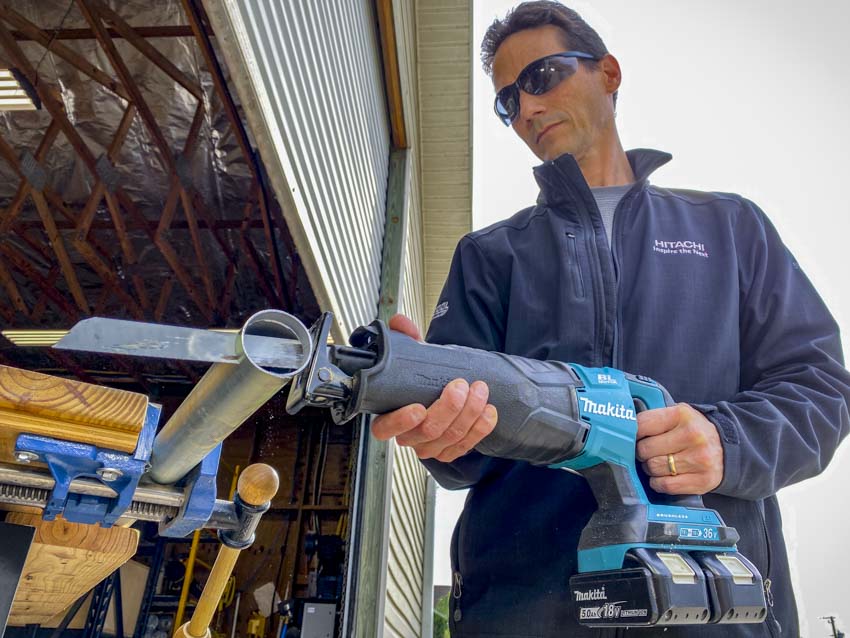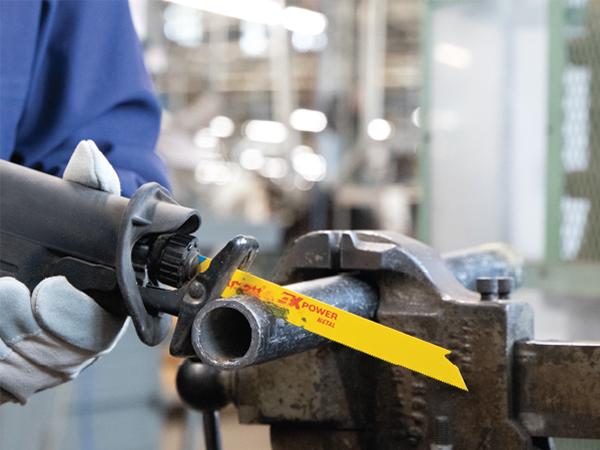Are you curious to know if a reciprocating saw can cut metal? Well, you’re in the right place! If you’ve ever come across a reciprocating saw, you might have wondered about its capabilities. Can it handle tough materials like metal? In this article, we’ll explore the answer to that question and shed some light on the amazing world of reciprocating saws.
Reciprocating saws, also known as sawzalls, are versatile power tools that can make quick work of various cutting tasks. But can they tackle metal? The short answer is yes! Reciprocating saws are specially designed to handle a wide range of materials, including metal. With the right blade and technique, you can slice through metal pipes, nails, and even thick metal sheets without breaking a sweat.
So, how does a reciprocating saw cut through metal? The secret lies in its back-and-forth cutting motion, which gives it the name “reciprocating.” This saw uses a push-and-pull action to move the blade rapidly, allowing it to slice through metal with ease. Whether you’re a DIY enthusiast or a professional tradesperson, a reciprocating saw can be a game-changer when it comes to cutting metal efficiently and effectively. So, let’s dive deeper into the world of reciprocating saws and discover their metal-cutting capabilities!
In this article, we’ll discuss the different types of blades you can use to cut metal, the best techniques to ensure clean and precise cuts, and some safety tips to keep in mind while using a reciprocating saw. By the end, you’ll have all the knowledge you need to confidently tackle your next metal-cutting project with a reciprocating saw. So, let’s get started and unleash the cutting power of this incredible tool!

Can a Reciprocating Saw Cut Metal?
A reciprocating saw is a versatile and powerful tool that is commonly used for various tasks such as cutting through wood, plastic, and even metal. Many DIY enthusiasts and professionals alike wonder if a reciprocating saw is suitable for cutting metal. In this article, we will explore the capabilities of a reciprocating saw when it comes to cutting metal, the different types of blades that can be used, and the precautions you should take while working with this tool.
Can You Use a Reciprocating Saw to Cut Metal?
Yes, you can definitely use a reciprocating saw to cut metal. These saws are designed to tackle tough materials, and with the right blade, they can make quick work of metal cutting tasks. However, it is important to note that not all reciprocating saw blades are suitable for cutting metal. Different blades are designed for specific materials, so it’s crucial to choose the right blade for the job.
Choosing the Right Blade for Metal Cutting
When it comes to cutting metal with a reciprocating saw, using a blade specifically designed for metal is essential. There are several types of blades that are commonly used for metal cutting, including bi-metal, carbide-tipped, and diamond-grit blades.
Bi-metal blades are the most versatile and widely used for cutting metal. They consist of a hardened steel edge with teeth made of high-speed steel, offering both durability and flexibility. These blades can cut through a wide range of metals, including steel, aluminum, and copper.
Carbide-tipped blades are another option for cutting metal. These blades feature carbide teeth that are more resistant to wear and can deliver cleaner and smoother cuts. They are ideal for cutting through hard metals such as cast iron.
Diamond-grit blades, as the name suggests, are embedded with diamond particles. These blades are specifically designed for cutting through hard materials like tile, masonry, and some metals. While they are not as versatile as bi-metal or carbide-tipped blades, they excel in cutting through materials like stainless steel.
Using a Reciprocating Saw to Cut Metal: Safety Precautions
While a reciprocating saw can be a powerful tool for cutting metal, it is important to take proper safety precautions to avoid accidents and injuries.
- Wear appropriate safety gear, including safety glasses, gloves, and ear protection.
- Make sure the work area is well-lit and clear of any obstructions.
- Secure the material you are cutting to ensure stability and prevent kickback.
- Start cutting at a slow speed and gradually increase the speed as needed.
- Do not force the blade through the metal; let the saw do the work and apply steady, even pressure.
- Avoid reaching behind the blade or placing your hand in the cutting path.
- Regularly inspect and maintain your reciprocating saw and replace blades as needed.
Benefits of Using a Reciprocating Saw for Metal Cutting
Using a reciprocating saw for metal cutting offers several advantages:
- Efficiency: Reciprocating saws are known for their speed and efficiency, making them a great choice for cutting through metal quickly.
- Versatility: With the right blade, a reciprocating saw can cut through a wide range of metal materials, giving you the flexibility to tackle various projects.
- Portability: Reciprocating saws are lightweight and portable, making them easy to maneuver and transport to different job sites.
- Accessibility: The design of a reciprocating saw allows for easy access to tight or hard-to-reach areas, making it a valuable tool in metal cutting tasks.
Other Metal Cutting Options
While a reciprocating saw is a great tool for cutting metal, there are other options available depending on the specific task at hand.
Band Saws
Band saws are another popular option for cutting metal. They offer precision and the ability to handle larger and thicker pieces of metal. Band saws are commonly used in industrial settings but can also be found in some workshops or fabrication shops.
Angle Grinders
Angle grinders equipped with cutting discs can also be used for metal cutting. These tools are versatile and can easily cut through various metals, including steel and iron. Angle grinders are commonly used in construction and metalworking applications.
Tips for Successful Metal Cutting with a Reciprocating Saw
To ensure successful metal cutting with a reciprocating saw, consider the following tips:
- Choose the appropriate blade for the type of metal you are cutting.
- Set the right speed and stroke length on your reciprocating saw.
- Use clamps or a vise to secure the material for stability.
- Apply cutting fluid or lubricant to keep the blade cool and reduce friction.
- Take breaks as needed to allow the saw and blade to cool down.
In conclusion, a reciprocating saw can indeed cut metal with the right blade equipped. By choosing the appropriate blade, following the necessary safety precautions, and employing proper techniques, you can efficiently and effectively cut through various metal materials with a reciprocating saw.
Key Takeaways: Can a Reciprocating Saw Cut Metal?
2. It is important to use the right type of blade for cutting metal.
3. Bi-metal blades are the best option for cutting metal with a reciprocating saw.
4. Reciprocating saws are commonly used for demolition work on metal structures.
5. Always wear appropriate safety gear, such as goggles and gloves, when working with a reciprocating saw.
Frequently Asked Questions
Welcome to our FAQ section where we answer common questions about using a reciprocating saw to cut metal. Whether you’re a seasoned DIY enthusiast or a beginner, understanding the capabilities of a reciprocating saw is crucial for your metal-cutting projects. Read on to find answers to your burning questions.
1. What type of metal can a reciprocating saw cut?
A reciprocating saw is a versatile tool that can cut through a wide range of metals, such as steel, aluminum, copper, and even cast iron. However, it’s important to note that the thickness of the metal will determine the saw’s effectiveness. For thinner metals, the saw can effortlessly make precise cuts, but for thicker metals, it might require more time and effort.
When working with metal, it is advisable to use the appropriate blade designed specifically for metal cutting. These blades are typically made from bi-metal or carbide, which ensures durability and precision when cutting through metal materials.
2. Can a reciprocating saw make clean cuts in metal?
While a reciprocating saw is excellent for making rough cuts in metal, achieving perfectly clean cuts might require additional steps. The nature of the reciprocating action can produce more rugged cuts with visible marks or burrs. However, there are a few techniques to improve the cleanliness of your cuts.
Using a high-quality blade designed for metal cutting can minimize rough edges. Additionally, taking your time and using a steady hand, as well as using clamps or guides to ensure a straight cut, will go a long way in enhancing the quality of the cut. Finally, sanding or filing the edges after cutting can help remove any remaining burrs and create a smoother finish.
3. Is it safe to cut metal with a reciprocating saw?
Yes, it is safe to cut metal with a reciprocating saw as long as you take the necessary precautions. Safety should always be a priority when using any power tool. To ensure your safety, wear proper protective gear such as safety glasses to shield your eyes, as well as gloves to protect your hands from sharp edges and metal shavings.
Additionally, make sure the workpiece is securely clamped or held in place to prevent it from moving during the cutting process. Take your time, maintain a firm grip on the saw, and allow the blade to do the work without applying excessive force. Finally, ensure that the saw is unplugged or the battery is removed before changing blades or making any adjustments.
4. Can a reciprocating saw cut through thick metal?
A reciprocating saw can cut through thick metal, but it may require some patience and the right blade. The cutting capacity of a reciprocating saw depends on its power output, stroke length, and the material being cut.
For thicker metals, you’ll need a saw with higher power and a longer stroke length to ensure efficient cutting. Additionally, using the appropriate blade designed specifically for cutting thick metal will make the process smoother. Take your time and let the saw do the work, allowing the blade to gradually cut through the metal to avoid overheating or damaging the blade.
5. Are there any limitations to cutting metal with a reciprocating saw?
While a reciprocating saw is a versatile tool for cutting metal, it does have its limitations. One significant limitation is the inability to make precise or intricate cuts. The back-and-forth motion of the blade can make it challenging to create intricate shapes or cuts with extreme accuracy.
Additionally, reciprocating saws tend to vibrate more, which can pose challenges when cutting for extended periods. Holding onto the saw firmly and taking regular breaks can help minimize fatigue and ensure accurate cutting. Finally, cutting through extremely hard metals or heavily reinforced materials might require specialized tools beyond the capabilities of a reciprocating saw.

Summary
A reciprocating saw is a handy tool that can cut through different materials, including metal. It has a saw blade that moves back and forth, making it perfect for metal cutting jobs. The key is to use the right type of blade for cutting metal, such as a bi-metal or carbide blade, which are designed to withstand the hardness of metal. However, it’s important to note that when using a reciprocating saw to cut metal, safety precautions must be taken, such as wearing protective goggles and gloves.
In conclusion, yes, a reciprocating saw can cut metal, but it requires the proper blade and safety measures. So, if you need to cut through metal, don’t worry, the reciprocating saw has got you covered! Just make sure to choose the right blade and stay safe while using it.
